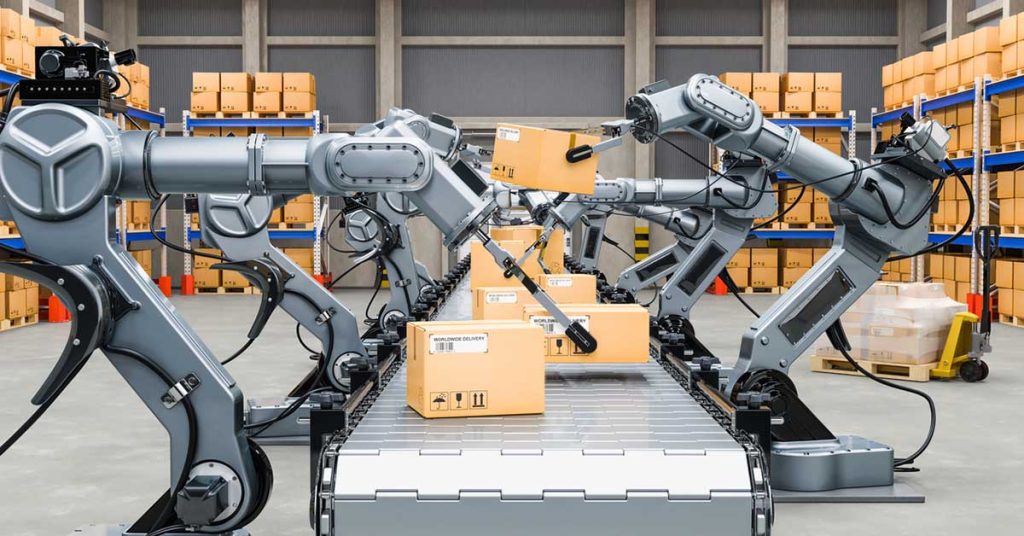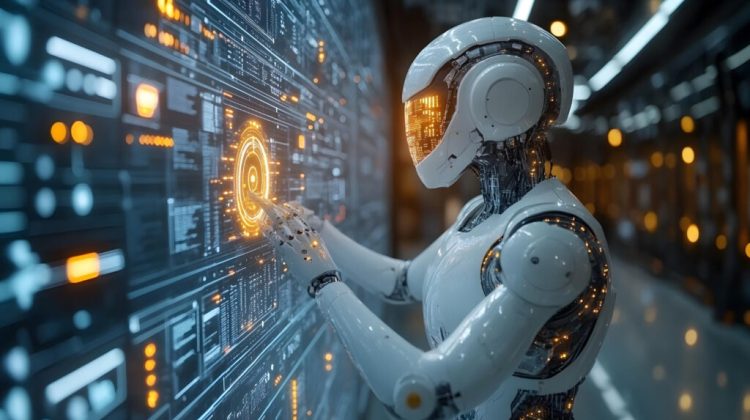Introduction
The synergy between artificial intelligence (AI) and robotics has emerged as one of the most transformative forces in the modern technological landscape. AI is fundamentally changing the way robots are designed, programmed, and deployed, enabling them to carry out tasks that were once considered to be uniquely human. As a core component of contemporary robotics, AI is not only enhancing the capabilities of machines but is also pushing the boundaries of automation, machine learning, and interaction with human environments.
Artificial Intelligence (AI) in robotics is the driving force behind the growing intelligence of robots. AI allows robots to analyze complex data, adapt to dynamic environments, make decisions, and interact intelligently with humans. From industrial robots in manufacturing plants to service robots in healthcare and autonomous vehicles on the road, AI is the engine that powers the advanced capabilities of modern robots. This article will explore the fundamental role of AI in contemporary robotics, its various applications, challenges, and the future possibilities it holds in revolutionizing industries worldwide.
1. The Integration of AI into Robotics
1.1 What is AI in Robotics?
AI in robotics refers to the implementation of algorithms and computational techniques that allow robots to perform tasks autonomously or semi-autonomously, based on sensory input and pre-programmed logic. It equips robots with the ability to perceive their surroundings, make informed decisions, and perform specific tasks with precision. Through AI, robots can improve their performance over time by learning from experience and adapting to new situations.
AI in robotics is generally divided into several core areas:
- Perception: AI-powered perception systems enable robots to recognize objects, map their surroundings, and process sensory data. This includes technologies such as computer vision, LiDAR, and radar.
- Planning and Decision-Making: Through decision-making algorithms, robots can decide on the best course of action to accomplish a given task. This might involve planning paths, choosing strategies, or adjusting behaviors based on environmental factors.
- Learning: Machine learning, a subset of AI, is used to enable robots to learn from data. By using deep learning or reinforcement learning techniques, robots can improve their performance and decision-making abilities without human intervention.
- Human-Robot Interaction (HRI): AI allows robots to understand and respond to human gestures, speech, and actions, enabling effective collaboration between humans and robots. This area of AI is crucial for applications in healthcare, customer service, and home automation.
1.2 Historical Development of AI in Robotics
The integration of AI into robotics has evolved over several decades. Early robots were typically hard-coded with specific instructions and could only perform a limited set of tasks in controlled environments. The first wave of robotic technology, known as industrial robots, emerged in the 1960s and was primarily used for tasks such as assembly line work. These robots were powerful but lacked flexibility and adaptability.
In the 1990s and early 2000s, advances in AI and computational power led to the development of more versatile robots that could handle a wider range of tasks, including navigating complex environments and interacting with humans. Artificial neural networks and machine learning algorithms began to be incorporated into robotic systems, enabling robots to “learn” from their environments and experience, leading to smarter, more adaptable machines.
Today, robots powered by AI can perform highly sophisticated tasks such as autonomous driving, robotic surgery, and advanced manufacturing. The pace of progress is accelerating as AI continues to improve, leading to more capable robots with increasingly complex decision-making abilities.
2. Key Technologies Driving AI in Robotics
2.1 Machine Learning and Deep Learning
At the heart of AI in robotics is machine learning (ML), a subset of AI that allows robots to improve their performance by analyzing data and identifying patterns. ML algorithms can be classified into three types:
- Supervised Learning: In supervised learning, the robot is provided with labeled data, and the algorithm learns to map inputs to correct outputs. For example, a robot could learn to recognize objects by being shown labeled images of various objects.
- Unsupervised Learning: In unsupervised learning, the robot must identify patterns in data without labeled examples. This is useful for tasks like clustering objects or identifying novel situations.
- Reinforcement Learning: In reinforcement learning, robots learn through trial and error, receiving feedback based on the actions they take. This approach is widely used in tasks requiring long-term planning and decision-making, such as robotic navigation and game-playing.
Deep learning, a subset of machine learning, is particularly influential in AI-powered robots. Deep learning networks, such as convolutional neural networks (CNNs) for image recognition and recurrent neural networks (RNNs) for sequential tasks, allow robots to analyze sensory data like images, sound, and video with impressive accuracy.
2.2 Computer Vision and Image Processing
Robotic perception is heavily reliant on computer vision, which allows robots to interpret and understand visual data. Through advanced image processing techniques, robots can detect and identify objects, track movement, and build 3D maps of their environments. Key components of computer vision in robotics include:
- Object Detection and Recognition: Robots use machine learning models to recognize and identify objects in their field of view, enabling them to understand their surroundings. This is crucial for tasks such as picking and placing objects, as well as navigation.
- Visual SLAM (Simultaneous Localization and Mapping): SLAM algorithms allow robots to create a map of an unknown environment while simultaneously tracking their position within it. This is vital for autonomous navigation in both indoor and outdoor settings.
- 3D Perception: The ability to perceive depth and distance is essential for robots to interact safely with humans and other objects. LiDAR and stereo cameras are often used to gather depth information.
2.3 Natural Language Processing (NLP)
Natural language processing is another important component of AI in robotics. NLP enables robots to understand, interpret, and respond to human language. By processing text or speech, robots can interact with humans in a more natural and intuitive way. Applications include:
- Voice Assistants: Robots equipped with NLP can understand commands and questions from humans, enabling interaction through spoken language. This is particularly useful in applications like home automation and customer service robots.
- Dialog Systems: Advanced NLP algorithms allow robots to engage in extended dialogues with humans, improving their ability to follow complex instructions or provide assistance.
- Context Understanding: Robots can use NLP to infer context from conversations, allowing for more personalized and effective interactions. For instance, a healthcare robot could understand patient needs based on their speech patterns and respond accordingly.

3. Applications of AI in Robotics
AI is unlocking a wide range of applications for robotics across various industries. Some of the most notable applications include:
3.1 Autonomous Vehicles
AI-powered robots, or autonomous vehicles, represent one of the most promising applications of robotics in modern society. Self-driving cars rely on a combination of sensors, AI algorithms, and deep learning to navigate roads, avoid obstacles, and interact with other drivers and pedestrians. The integration of AI into autonomous vehicles enables them to:
- Recognize and predict the behavior of other vehicles and pedestrians
- Make decisions in real-time regarding speed, direction, and safety
- Adapt to changing road conditions and environments
Autonomous vehicles are expected to reduce traffic accidents, improve transportation efficiency, and revolutionize urban mobility.
3.2 Industrial Robots
AI is increasingly being used in industrial robotics, particularly in manufacturing and production environments. Robots equipped with AI and machine learning algorithms can now:
- Learn from their environment to optimize production processes
- Perform quality control by detecting defects and inconsistencies
- Collaborate with human workers in shared workspaces, known as cobots (collaborative robots)
The ability of AI-powered robots to adapt to changing conditions and learn new tasks makes them invaluable in modern manufacturing.
3.3 Healthcare and Surgery
AI-powered robots are also making significant strides in healthcare. Robotic surgery systems use AI to assist surgeons by providing real-time data and precision during operations. These systems offer advantages such as:
- Minimally invasive procedures with greater accuracy
- Real-time monitoring of vital signs and patient conditions
- Reduced recovery times and improved patient outcomes
In addition, robots powered by AI are being used in elderly care and patient assistance, where they can perform tasks like delivering medications, assisting with mobility, and monitoring patient health.
3.4 Service Robots
In customer service and hospitality, robots powered by AI are transforming the way businesses interact with customers. AI-driven service robots can:
- Answer customer inquiries and assist with navigation in public spaces
- Serve food and beverages in restaurants
- Provide information in museums, airports, and hotels
These robots are capable of learning from customer interactions, improving their performance over time.
4. Challenges and Ethical Considerations
4.1 Challenges in AI and Robotics
Despite the remarkable advancements in AI and robotics, several challenges remain:
- Computational Power: AI algorithms in robotics require significant computational resources, particularly for tasks like real-time image processing and decision-making.
- Sensor Reliability: Robots rely heavily on sensors for perception. However, sensor data can be noisy or incomplete, which can impact the robot’s ability to operate effectively.
- Safety: As robots become more autonomous, ensuring their safety when interacting with humans becomes paramount. This includes developing robust safety protocols and mechanisms for emergency intervention.
4.2 Ethical Concerns
The rise of AI in robotics also brings ethical concerns, including:
- Job displacement: As robots become more capable, concerns about their impact on human employment in sectors like manufacturing, retail, and transportation grow.
- Privacy: Robots that collect and process large amounts of personal data raise questions about privacy and data security.
- Autonomous Decision-Making: The potential for robots to make decisions without human intervention, especially in critical areas like healthcare and defense, introduces concerns about accountability and control.
5. The Future of AI in Robotics
The future of AI in robotics is bright, with ongoing advancements likely to lead to even smarter, more capable robots. Some of the key trends that will shape the future of AI in robotics include:
- Advancements in AI algorithms that will enable robots to learn faster and more efficiently.
- Improved human-robot collaboration, where robots will seamlessly work alongside humans in complex environments.
- Autonomous systems that can operate in real-world, unstructured environments without the need for human intervention.
Conclusion
AI is undeniably one of the core pillars of modern robotics technology. By enabling robots to perceive, learn, adapt, and make decisions autonomously, AI is opening up new possibilities in industries ranging from manufacturing to healthcare to transportation. As AI technology continues to evolve, the future of robotics promises even more sophisticated and transformative applications, making our world smarter, safer, and more efficient. However, addressing challenges related to safety, ethics, and job displacement will be crucial as we move toward a future powered by intelligent machines.











































